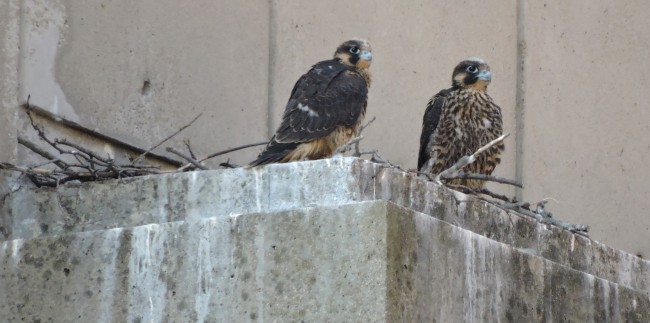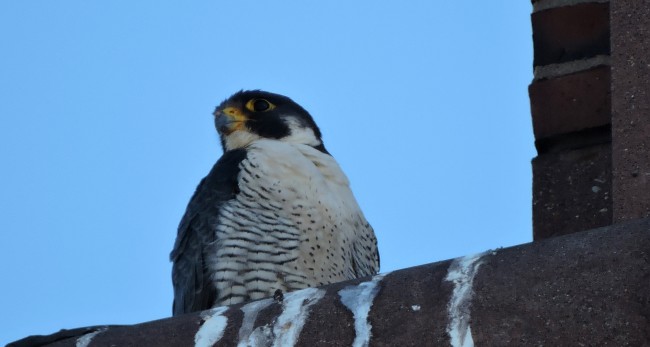Peregrine Falcons Find Home on Medical Campus
 A family of peregrine falcons have made a nest on a window ledge atop the Solomon Carter Fuller Mental Health Building. Photos by Anita DeStefano, PhD, professor of Biostatistics and associate director of the BUMC Genome Science Institute.
A family of peregrine falcons have made a nest on a window ledge atop the Solomon Carter Fuller Mental Health Building. Photos by Anita DeStefano, PhD, professor of Biostatistics and associate director of the BUMC Genome Science Institute.
High above Talbot Green a pair of watchful eyes scopes the concrete canyon below looking for its next prey. This isn’t a scene from Mission Impossible. It’s more like a National Geographic documentary.
Perched on a window ledge atop the Solomon Carter Fuller Mental Health Building, two peregrine falcons have decided to make the BU Medical Campus their home.
 “It’s simply fascinating that such beautiful wildlife can exist in this urban area,” said Anita DeStefano, PhD, professor of Biostatistics and associate director of the BUMC Genome Science Institute.
“It’s simply fascinating that such beautiful wildlife can exist in this urban area,” said Anita DeStefano, PhD, professor of Biostatistics and associate director of the BUMC Genome Science Institute.
DeStefano noticed the male and female falcons in late spring and began taking pictures of the birds from the rooftop of the medical campus parking garage. In early summer, she observed two falcon chicks in addition to the adults. After reading a recent article on BU Today about another pair of falcons on the Charles River campus, DeStefano contacted Ursula and Dave Goodine, certified volunteer observers for Massachusetts Division of Fisheries and Wildlife.
That evening, DeStefano met with the Goodines to point out the nest site and to observe the adults with one of their fledglings.
According to Ursula Goodine, peregrine falcons are the fastest flying birds in the world – reaching speeds of 200 miles per hour during a dive. They feed on pigeons and other small birds.
In 1964 nesting pairs of Peregrines were extinct in the eastern United States, but over time, conservation success was responsible for changing them from “endangered” to “protected” status. There are now more than 30 nesting pairs in Massachusetts.
Contrary to popular belief, peregrine falcons do not build a nest. They lay their eggs on cliffs.
“As the falcon population increased, some birds looked for other territories and began using tall buildings instead of the natural landscape of cliffs and quarry ledges to raise their young,” said Goodine. “This just reveals how adaptable peregrines have become in order to perpetuate their species.”
In an effort to help facilitate a safer environment for the birds, experts from the MassWildlife Natural Heritage and Endangered Species program have set up simple wooden “nest-boxes” lined with gravel in several locations throughout the city.
The Goodines now are working on a plan to have one installed on the BU Medical Campus this fall to give the birds time to acclimate to its presence. They hope the pair of falcons will use it next spring.
“Reintroduction programs have helped Peregrines make an amazing recovery,” said Goodine. “While city living poses all kinds of dangers to these birds, they are resilient and their population has rebounded quite well.”
View all posts